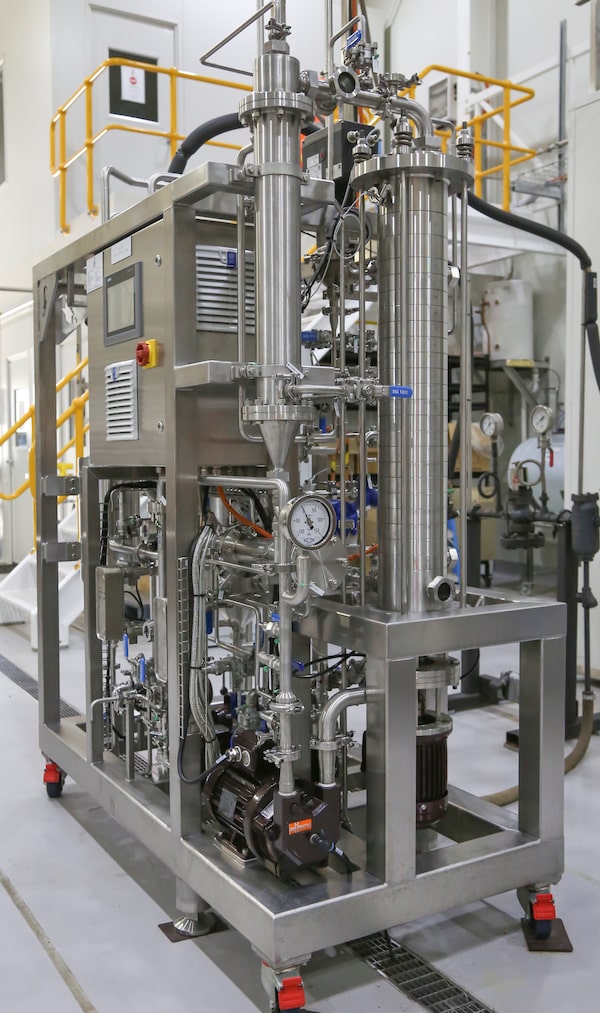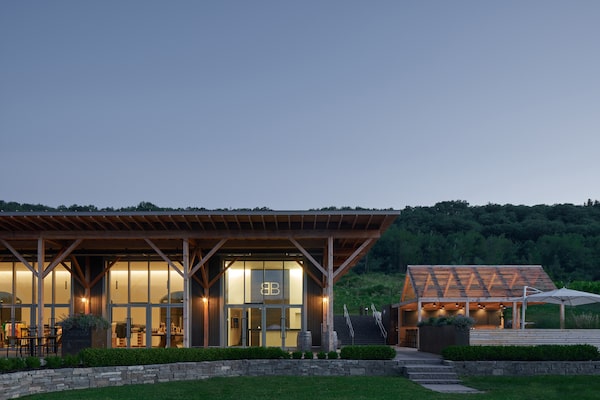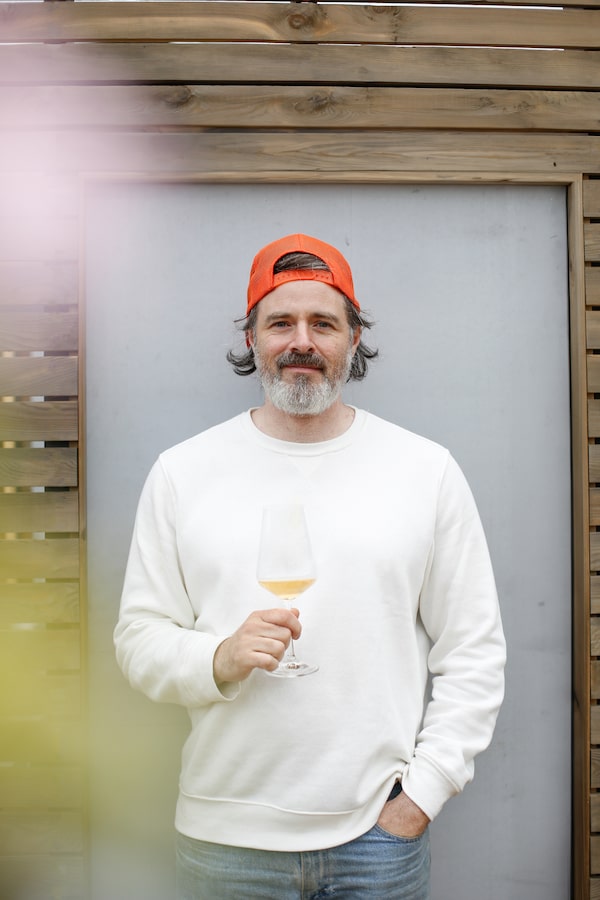
Wes Pearson, a Canadian who works as a researcher for the Australian Wine Research Institute in Adelaide, South Australia.Eric Wilkes/Supplied
Earlier this month, a 13-generation winemaking family in the Alsace region of France announced the launch of their first alcohol-free riesling. This would have been revolutionary in the wine world – if the news wasn’t only an April Fool’s joke. “This principle runs counter to our entire family culture,” the Hugel family explained in a follow-up message. “In our eyes, the only true alcohol-free alternative is water.”
Alcohol-free wine might be a joke to some – isn’t that just grape juice? – but as wine consumption declines around the world, it’s a chance for interested parties to innovate. Though producers with a dedicated consumer base like the Hugel family aren’t as commercially motivated to stay relevant in a changing marketplace, others are looking to meet the rising demand. Just like the “near beer” brands, which took decades to refine a balanced and flavourful product that tastes like “real” beer, wine producers, who hope to enjoy the same success, have their work cut out for them. So, why is it so difficult to make no-alcohol wines that taste like the real thing?
The major issue is collateral damage, explains Wes Pearson, senior research scientist for the Australian Wine Research Institute who has been looking at how to improve the quality of non-alcoholic wine since 2019. Removing the alcohol from finished wine also strips the majority of aroma and flavour compounds and results in a significant change in the body and texture, he says. Pearson’s sensory research shows tasters highlight a lack of “wine-likeness” in most non-alcoholic products.

Pearson says removing the alcohol from finished wine also strips the majority of aroma and flavour compounds.Supplied
“If it was just a question of flavour, we could concoct some sort of flavour cocktail like they do with non-alcoholic beer,” says the Winnipeg native, who has worked in the Australian wine industry since 2008.
The big problem is replacing that sensation of ethanol. “How can we fill that hole in the doughnut, if you will, that’s left on the palate?”
Many non-alcoholic wines bump up the residual sweetness by adding concentrated grapes, sugars and juice to compensate for a lack of body – what some would describe as “mouthfeel” – but that doesn’t offer a similar profile. Without evaporating alcohol to help transmit aroma and flavour, these beverages seem dull and flat. Moreover, increased sugar levels make the product harder to sell to who industry researchers call “health-conscious drinkers,” the growing category of consumers interested in moderation and mindful of what they are putting into their bodies.
Based in a lab at the University of Adelaide, Pearson’s research is funded by stakeholders from across the Australian winemaking industry, including those specializing in winery equipment and yeast, bacteria and specialty ingredients for fermentation.
A specialized piece of equipment allows researchers to do vacuum distillation on small batches of wine, 50 or 60 litres instead of the 10,000 litres required by a commercial machine. This allows continuing study into the nuances of distillation in the hopes of protecting the aroma and flavour in the product or finding ways to capture it and add those compounds back into a zero per cent alcohol product.

The Benjamin Bridge vineyard in Nova Scotia.Benjamin Bridge
Studies are hindered by the fact that alcohol acts as a preservative. Once alcohol is removed, the lab samples aren’t shelf-stable and can be spoiled by oxidation or contamination by microbes.
Pearson says the research seeks to answer two major questions: “What is the potential for these products? How can we make them better?”
Five years in, the answers remain elusive. “I think we understand the problems better,” Pearson explains.
Drawing inspiration from the success of non-alcoholic beer can only take the wine industry’s quest so far. Beer’s alcohol by volume can range between 3 to 13 per cent, with most styles on the market falling between 4 and 7 per cent. A wine’s character is more reliant on its alcohol content, with the average glass containing between 11 per cent to 13 per cent alcohol by volume. There’s more to remove, which means more harm to compounds that provide aroma and flavour to the wine.
New innovations in the vineyard and winery are being developed to produce wines with lower alcohol levels so there’s less to remove. But all this effort comes at a cost., including the expense of removing the alcohol – with machinery typically operated by an external company because of its capital-intensive, space-consuming and specialized nature. You can expect to spend more, rather than less, for a low- or no-alcohol wine, which puts the category at risk. It puts a premium price on a product that doesn’t match the true expression and experience of an actual bottle of wine.
Meanwhile, the research has created a growing category of lower-alcohol, low-calorie wines, under 10 per cent alcohol by volume, that don’t compromise on flavour. Some white wine styles are particularly well-suited, such as Kim Crawford Illuminate Sauvignon Blanc, Stoneleigh Lighter Sauvignon Blanc and The Doctors’ Riesling. These sell for around $20 a bottle, but they smell and taste like they should. (Historically some white wine styles, Mosel riesling, Vinho Verde and Moscato d’Asti have always been low alcohol expressions, but not lower in calories by design.) Most calories in wine come from alcohol – not carbohydrates or sugar – with a typical five-ounce glass of white wine containing 120 calories. The same portion of a lower-alcohol wine has between a quarter and one-third fewer calories.

Head winemaker at Benjamin Bridge Jean-Benoit Deslauriers was quick to embrace wine-style zero-alcohol beverages.Benjamin Bridge
Challenges in the non-alcoholic field have led to the rise of wine-seeming products, which use tea, hops and other food ingredients for flavour, complexity and texture. Introduced in 2021, Proxies was an early success, offering a range of wine alternatives created by thoughtful blends of grapes, teas, bitters, vinegars and other fruits. British wine writer Matthew Jukes created a series of concentrated fruit vinegar syrups, also known as a shrubs, for Jukes Cordialities, which come in non-alcoholic red, white and rosé versions that use organic apple cider vinegar as a base.
Winemaker Jean-Benoit Deslauriers, who is known for the aromatic white wines and traditional method sparkling wines made at Nova Scotia’s Benjamin Bridge, was also quick to embrace wine-style zero-alcohol beverages. His first foray into the market came by turning Piquette, an ancient style of low-alcohol wine made by adding water and sugar to the leftover grape skins, stems and seeds that remain after pressing, into an enjoyable zero-alcohol sugar-free wine spritzer.
“Piquette Zero was the easiest starting point because there’s no sensory reference point, they have the opportunity to be whatever they can be,” says Deslauriers, who has overseen the development of three different styles of Piquette Zero, including original, ruby and pink, which are sold nationally in 250 ml cans through Sobeys and Safeway stores, specialty liquor stores and online.
More non-alcoholic wine experimentation carries on behind-the-scenes at the Gaspereau Valley vineyard. This year Benjamin Bridge plans to introduce a non-alcoholic version of their popular Nova 7, an intensely aromatic and semi-sweet white that has become one of Canada’s bestselling brands since its debut in 2007. The stakes are high because of the success of the original Nova 7 – a low-alcohol (6.8 per cent alcohol by volume) blend of muscat, ortega, riesling, geisenheim, l’Acadie, vidal and petite pearl.
“Nova 0 will be subjected to ruthless analysis by people who appreciate the original. That’s why we took the time to ensure it lives up to that challenge,” says Deslauriers.
Benjamin Bridge’s goal is to be the first to produce a non-alcoholic wine that’s profoundly connected to the place where the grapes are grown, and done so by natural means. “It’s not going to happen tomorrow, we may not succeed … but we hope to be the first to do it.”
Current releases might not be reflective of the real deal yet, and possibly never will, but there’s an emerging category of wine adjacent beverages to explore. Take the alcohol out of wine and it’s no longer wine, so producers aren’t bound by the same rules. They just need to focus on delivering something delicious and appetizing.